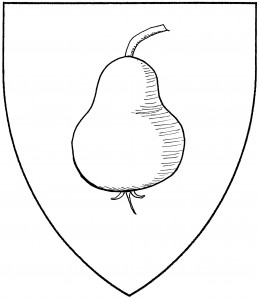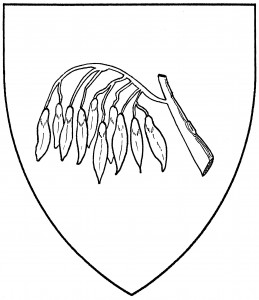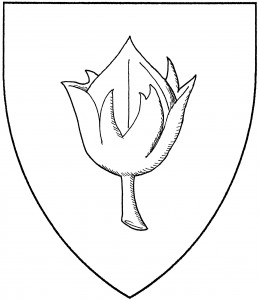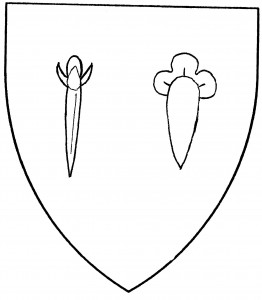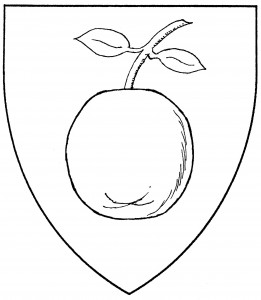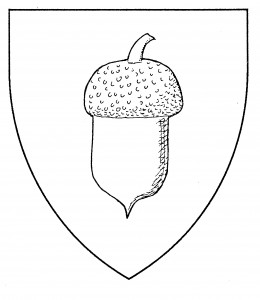The term “fruit”, as it is used in heraldry, denotes the seed-pod of most plants; the term is specially reserved for the edible portions of those plants. A full plant or tree shown bearing such fruit may be blazoned “fructed”.
Any fruit known to period Europeans may be used in Society armory – though, if the fruit is not itself European, its use is considered a step from period practice. (An exception would be made for non-European fruit actually used in period European armory, but no examples have been adduced.) Examples of fruit found in period armory include cherries, in the arms of Cheriton, c.1436 [Parker 104]; pears, in the arms of Perello, Visconte de Rodes, 1366 [Gelre 63]; peaches, in the badge of Pechey, d.1522 [Hope 191]; &c.
In general, those fruits that hang from a stem – i.e., those that grow from a tree or a vine – are shown with stem to chief by Society default; while those that grow from the ground are shown with the stem to base by Society default. Thus apples, strawberries, bunches of grapes, pears, &c, have stems to chief, while artichokes, ears of wheat, &c, have stems to base. There are numerous exceptions, of course: one such is the “hazelnut” or “filbert”, with its stem to base, as found in the canting arms of Haseley or Hasley, 1431 [DBA3 417].
A few notable Society usages: “Ash keys” are the fruits of the ash tree; the illustration shows clusters of ash keys dependent from their branches. By Society convention, a “strawberry proper” is gules: its slipping and leaving, if any, is vert, and its seeds may be Or or sable at the artist’s discretion. The modern trapezoidal strawberry varietal is considered a step from period practice. A “chili pepper proper” is red with a green cap, by Society convention (and carries the step from period practice mentioned above).
The illustrations show a pear, a cluster of ash keys, and a hazelnut. For specific entries, see: acorn, apple, clove, garlic, grain, grapes, hops, leek, mushroom, pine cone, pomegranate, poppy boll, turnip. See also cornucopia, garb, slip.
Deborah the Dextrous bears: Argent, three artichokes vert.
Kathryn Perry bears: Azure, three pears Or.
Cecily Pykerynge bears: Or, three strawberries proper.
Anne of Threadneedle Street bears: Azure, a chevron erminois cotised engrailed on the outer edges argent between two leaved ash branches fesswise reversed, dependent from each a cluster of ash keys, and a domestic cat couchant Or.
Alice Gardener bears: Vert, six peapods Or.
Tomas de Luna bears: Or, a radish bendwise gules leaved vert and a bordure rayonny gules.
Wulfflæd of Hæselbroce bears: Azure, in pale two hazelnuts Or.
